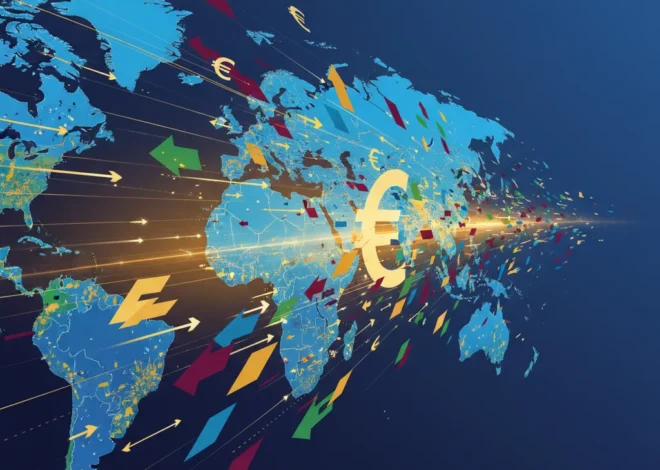
Beyond the Diamond: Decoding the Multi-Billion Dollar Economics of MLB’s New Streaming Era
In a move that signals a seismic shift in the sports media landscape, Major League Baseball has diversified its broadcasting portfolio, inking significant deals with streaming giants Netflix, legacy powerhouse ESPN, and NBCUniversal. While on the surface this appears to be a simple distribution agreement, a deeper analysis reveals a sophisticated financial strategy that reflects broader trends in the global economy, corporate investing, and the relentless evolution of financial technology. For investors, finance professionals, and business leaders, this isn’t just about baseball; it’s a masterclass in modern asset monetization and a bellwether for the future of high-value media content.
The announcement, as reported by the BBC, confirms that these platforms will broadcast select games over the coming seasons. This strategic fragmentation marks the end of an era dominated by traditional cable bundles and ushers in a new, more complex ecosystem. This is a calculated play by MLB to maximize revenue streams by meeting audiences where they are—scattered across a myriad of digital platforms. It’s a direct response to cord-cutting and the changing consumption habits of a new generation of fans, a move that has profound implications for the stock market valuations of all companies involved.
The Great Unbundling: A New Economic Playbook for Live Sports
For decades, the sports media model was straightforward: leagues sold exclusive rights to a handful of broadcasters who, in turn, used this premium content to anchor lucrative cable packages. This created a powerful, centralized revenue stream. However, the digital revolution has shattered this model. The rise of on-demand streaming has led to a “great unbundling,” where consumers pick and choose services, leaving traditional television providers in a precarious position.
Live sports, however, remain one of the few forms of content that are largely “DVR-proof,” demanding live viewership and generating immense advertising value. This makes sports rights one of the most valuable assets in the media world. A 2023 analysis from Forbes highlights that sports accounted for 97 of the top 100 most-watched television broadcasts. MLB’s strategy is to slice this high-value asset into multiple pieces and sell them to different bidders, each with a unique audience and strategic goal. This diversification mitigates risk and taps into the massive content budgets of tech giants, which now dwarf those of traditional media companies. From an economics perspective, it’s a classic case of price discrimination and market segmentation on a grand scale.
The Gilt-Edged Cage: Why the Bond Market Now Rules British Politics
A Strategic Deep Dive into the Key Players
To fully grasp the financial gravity of these deals, we must analyze the motivations of each corporate entity. This is not merely a content acquisition; it’s a strategic chess move in the fiercely competitive streaming wars.
Netflix: The New Frontier of Live Content
For Netflix, this is a landmark moment. After years of focusing exclusively on scripted and unscripted on-demand content, the move into live sports represents a significant strategic pivot. The company is betting that live events can reduce churn (the rate at which subscribers cancel) and attract a new demographic that was previously hesitant to subscribe. For investors, this signals Netflix’s ambition to become an all-encompassing entertainment hub. The success of this venture could dramatically impact its stock market performance, justifying a higher valuation by proving it can compete for assets previously dominated by Disney and Warner Bros. Discovery. This is a high-stakes bet on expanding their total addressable market.
ESPN (Disney): Defending the Throne
For ESPN, a subsidiary of The Walt Disney Company, these deals are about defending its historical dominance in sports broadcasting while navigating a difficult transition. The company is actively trying to build its direct-to-consumer offering, ESPN+, into a sustainable business. By retaining a package of MLB games, ESPN ensures it remains a critical destination for baseball fans. This is vital for Disney’s overall investing thesis, which hinges on successfully transitioning its legacy media assets to a streaming-first future. The financial health of ESPN is a cornerstone of Disney’s portfolio, and maintaining its grip on top-tier sports rights is non-negotiable.
NBCUniversal (Comcast): The Challenger’s Gambit
NBCUniversal’s involvement through its Peacock streaming service is a clear competitive play. Like its rivals, Comcast is using live sports to drive subscriptions and engagement for a service that is still fighting for market share. Each exclusive game is a powerful marketing tool and a reason for a consumer to choose Peacock over another service. This strategy demonstrates the premium that parent companies are willing to pay for content that can differentiate their platforms in a saturated market.
The following table provides a snapshot of the competitive landscape these media giants are navigating, illustrating the strategic importance of securing exclusive content like MLB games.
| Streaming Platform | Parent Company | Reported Subscribers (Global) | Key Sports Rights Portfolio (Examples) |
|---|---|---|---|
| Netflix | Netflix, Inc. | 270 Million+ (Q1 2024) | WWE Raw, NFL (select games), Boxing, MLB (select games) |
| ESPN+ | The Walt Disney Company | 24.8 Million (Q2 2024) | NFL, NBA, MLB, NHL, UFC, PGA Tour, College Football |
| Peacock | Comcast (NBCUniversal) | 34 Million (Q1 2024) | Olympics, NFL (Sunday Night Football), Premier League, MLB (Sunday Leadoff) |
The Macro-Economic Implications: Live Sports as a Financial Asset
This MLB deal is more than a media story; it’s a financial one. In an era of economic uncertainty, live sports rights have proven to be remarkably resilient, almost inflation-proof assets. Their value continues to climb because the demand from both audiences and advertisers is inelastic. This makes media companies with strong sports portfolios attractive to those interested in long-term investing.
For those involved in trading, the announcement of such deals can cause significant short-term volatility in the stocks of the companies involved. A successful bid can be seen as a sign of strength and forward-thinking strategy, boosting investor confidence. Conversely, losing out on a major sports package can be perceived as a strategic failure, potentially leading to a sell-off. The entire sports media ecosystem is a high-stakes game of financial chess, where every move is scrutinized by Wall Street.
Beyond the Balance Sheet: Unearthing the Psychological Allure of Gold
The Fintech Revolution: Powering the New Sports Economy
Underpinning this entire transition is a revolution in financial technology. The ability to seamlessly subscribe, pay, and manage multiple services is a fundamental challenge that fintech is solving. The fragmentation of media rights necessitates sophisticated direct-to-consumer banking and payment infrastructures.
Moreover, the digital-first nature of these platforms opens up new avenues for monetization that were impossible in the linear TV era. Consider the integration of sports betting. Platforms can now incorporate real-time odds and direct links to betting partners, creating a lucrative secondary revenue stream. This convergence of media, sports, and real-time financial transactions is a perfect example of fintech in action, transforming passive viewing into an interactive, transactional experience.
Looking ahead, the use of blockchain for verifying the authenticity of digital memorabilia (NFTs) or for creating more transparent and secure ticketing systems is a logical next step. As leagues like MLB build direct relationships with their fans through these digital platforms, they will increasingly leverage cutting-edge financial tools to deepen engagement and open up new economic opportunities.
Conclusion: A New Ballgame for Investors and Industry Leaders
Major League Baseball’s new deals with Netflix, ESPN, and NBCUniversal are a watershed moment, serving as a powerful indicator of the future of media, entertainment, and finance. This strategic pivot to a multi-platform distribution model is a sophisticated response to a rapidly changing consumer and technological landscape. It showcases a keen understanding of asset valuation, risk diversification, and the enduring economic power of live sports.
For investors and business leaders, the key takeaway is that the value is no longer just in the content itself, but in the strategic control of its distribution. The companies that can successfully navigate this fragmented landscape, leverage financial technology to enhance the user experience, and build sustainable direct-to-consumer businesses will be the winners in this new era. The game has changed, and the financial stakes have never been higher.
Beyond the Handshake: Why UK plc is Demanding More Than Just Reassurance from Downing Street


